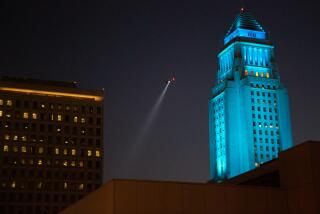Problem of Urban Noise Is Loud and Clear
- Share via
As a homeowner residing directly adjacent to a major freeway interchange that serves as a junction for FAA-mandated flight corridors for general aviation, my neighbors and I are unavoidably aware of the noise generated by ever-increasing helicopter overflights.
“Gotta Go! The Chase Is On!” (Jan. 15) served to illustrate the often crassly commercial motives for increased helicopter activity above residential areas 24/7. With the exception of police, fire and search-and-rescue teams, a reduction in other helicopter traffic would benefit, not degrade, the quality of life below, notwithstanding media mantras about the public’s right to know. During the brief, quieter times resulting from security measures enacted after Sept. 11, life on the ground in neighborhoods such as mine was measurably less jarring. To reduce the swarm of media helicopters, why can’t official agencies such as the LAPD, the CHP and Caltrans cover essential activities with their aircraft, pooling news to the TV stations? Caltrans has roadbed sensors that relay traffic flow data that could be transmitted to all the media for traffic updates.
Aside from the obvious dangers of police chases to those on the ground and of collisions to those in the air followed by crashes below, increasing findings by experts regarding the impact of urban noise on health should be of much greater interest to lawmakers and health and safety officials. Hopefully, in my lifetime.
Joanne Hedge
Glendale
More to Read
Inside the business of entertainment
The Wide Shot brings you news, analysis and insights on everything from streaming wars to production — and what it all means for the future.
You may occasionally receive promotional content from the Los Angeles Times.










